It’s interesting that the first electric vehicles of the modern era weren’t trucks – which have a lot more room than cars do for batteries. This matters because electric vehicle batteries take up a lot of space – which means less of that for people and stuff in an electric car.
In the case of the F-150 Lightning, the electric version of Ford’s F-150 pick-up, there’s even more room for stuff because there’s no engine under the hood – which is now an additional storage space.
And there’s still a bed out back – for more stuff.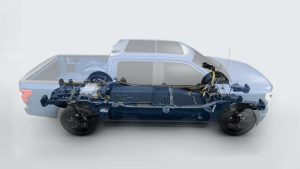
As for the batteries, they’re tucked out of sight under the truck – where there’s plenty of room for them.
This makes the Lightning more practical in that way than the regular F-150, which doesn’t have a trunk up front. And much more so than electric cars like the Tesla 3, which is a small car without a lot of extra room for cargo because so much available space is taken up by its batteries.
Plus, a Tesla can’t tow 10,000 lbs.
The Lightning can.
But there are things it can’t do – on account of the fact that it’s electric. Such as tow that weight very far without having to stop – and wait. You also can’t charge it very fast at home – and that can mean having to plan around the range you have left. Or the time you have to drive to – and from a “fast” charger.
The Lightning is an electrically-powered version of the best-selling F-150 half-ton pickup.
Unlike the non-electric versions of the F-150, the Lightning comes in only one version: Super Crew cab with a short (5.5 foot) bed. But it does come with your pick of batteries – and ranges – as well as trims.
Prices start at $48,769 for the base Pro trim which comes standard with a liquid-cooled 98 kWh battery pack and a 426 horsepower electric drive system. This version of the Lightning has an estimated full-charge range of 240 miles – up ten from the ’22 model. You can also pull up to 7,700 lbs. – when equipped with the optional Max Trailer Towing Package.
Otherwise, the maximum tow rating is 5,000 lbs.
A more powerful 131 kWh battery pack is available that bumps up the estimated full charge range to 320 miles. This version can also pull up to 10,000 lbs.
A top-of-the-line Platinum trim – which comes standard with the stronger battery and more range – stickers for $96,874.
What’s New 2023
The two big changes for the new model year are a slight uptick in estimated range and a big uptick in price – the latter having to do with the increased cost of the material used to make electric vehicle batteries, which are big batteries that take a lot of material to make them.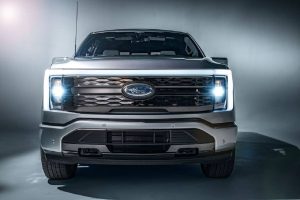
The ’22 Lighting’s base price was $7,000 less than the price of this year’s base Pro trim. But you do get an additional 10 miles of estimated range.
What’s Good
More cargo space than non-electric F-150.
More standard power than non-electric F-150.
Can be “refueled” at home.
What’s Not So Good
Short range relative to non-electric F-150.
Long recharge wait – even when “fast” charging.
Even shorter range (and more waiting) when towing.
Under The Hood
There isn’t anything under the hood of this truck – except room, for whatever you’d like to stow there. There are also outlets under there. These can be used to power high-draw electrical equipment and tools. There are more such outlets in the bed.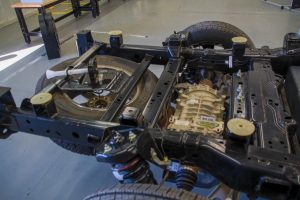
Under the truck lies the battery pack and a pair of electric motors driving all four wheels.
The Lightning does not need a two-speed transfer case for additional leverage because its electric motors make so much torque – 775 ft.-lbs.
That’s with either battery.
Acceleration is formidable – and silent. With its optional/stronger battery, the Lightning is capable of attaining 60 MPH in 3.8 seconds and running the quarter mile in 12.4 seconds, neck and neck with a V8-powered Mustang GT that weighs half as much.
You can recharge the Lightning either at home – using a standard 120V household appliance outlet or a 240V hook-up, if you have had your home wired for this. You can also charge the battery at commercial “fast” charging stations, where much higher voltage is available. These get you back on the road more quickly – but it costs more to use them than plugging in at home, because you’re paying for the high-load equipment that makes it possible to “fast” charge an electric vehicle.
And there’s a reason for the air fingers quotes, which we’ll get into now.
Speed is not a problem. Nor strength. The Lightning lives up to its name. Like its namesake, you don’t hear anything when it flashes. There is simply a brilliant flash of almost unbelievable acceleration. Without any hesitation. Without any interruption. It goes – fast – as long as you keep your foot in it, seemingly without end.
Because the Lighting is electric, it hasn’t got a transmission. The pair of electric motors (one up front, one out back) drive the wheels, directly. This eliminates not just the need of a transmission but also of shifting. The result of that is a continuous surge of silent thrust whenever you ask for it.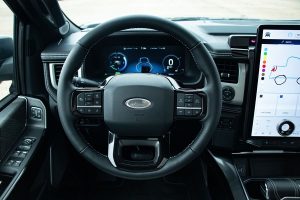
“Effortless” does not convey the ease with which the big fellow gets up to speed. You will find the window you used to need to risk pulling into fast-moving traffic has opened, considerably. It is great fun to pull into the slipstream and be going faster than the slipstream almost before you can blink. Watch others marvel at what looks to them like a suspension of the laws of physics.
Keep in mind this is a half-ton truck that weighs more than three tons, too.
But – in life, it seems there is always a but – if you use the Lightning’s speed (or strength, as to tow) you’ll soon have less of it. Or rather, of the power needed to provide it. Those motors – and all moving all that weight – require a lot of it. The Lightning has a massive battery pack – some 1,500 pounds of its more than 6,200 lb. curb weight. And the pack is powerful. But the power gets drawn down quickly, especially if you don’t drive gingerly. And even if you do, there’s effectively less than you think.
Or rather, than indicated.
During a week-long test drive (more details here) I found the indicated range was about 20 percent higher than the actual range – without a trailer attached. With a trailer attached, the reduction in actual range can be 50 percent or even higher, depending on the weight of the trailer.
Cold – and the use of electrically powered accessories noticeably increases the loss. Also uphill climbs – though if you are able to go back down the hill, you can recover some of what you lost via the good offices of regenerative braking, which converts the kinetic energy of motion back into electricity, use the motors as generators. This can also be used to slow the Lightning without using the brakes, in the manner of engine braking.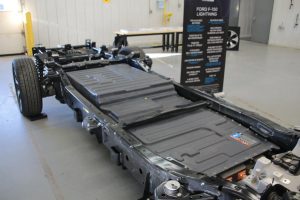
Just sans the engine.
The Lightning does not feel as heavy as it is, perhaps because the added weight is spread out evenly over its length. The only noticeable negative of all that weight is the effect on range. Which isn’t a problem, per se – if it didn’t entail such frequent – and long – waits.
A V8 Mustang GT doesn’t have much range, either – especially if you use its available power. But you can run one down to fumes and be back to fully fueled in about five minutes. This you cannot do in the Lightning or an electric vehicle because of the time it takes to put even a partial charge back into an electric vehicle’s battery.
Ford says – and it probably true – that you can “fast” charge the Lightning’s battery to 80 percent capacity in as little as 44 minutes. But that is only 80 percent full – and it isn’t very fast, relative to how quickly you could refill (to full) something like the Mustang GT. Keeping in mind also that those 44 minutes aren’t spent at home. You must spend them at the “fast” charger – and then you can drive home.
PS: The reason you shouldn’t “fast” charge an electric vehicle’s battery beyond 80 percent full is because “fast” charging is hard on the battery (more about this follows below) and there is an increased risk of fire, too.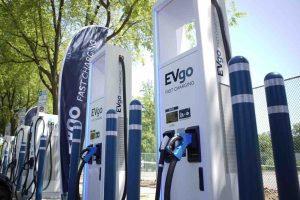
Also, I found that not all “fast” chargers are created equal. Some are slower than others. I spent an hour and 15 minutes at one that only instilled 100 miles of range – or about a third of the total capacity of the tested Lightning’s extended range battery – after all that waiting.
You can charge at home, but this is even slower. It takes overnight, at least – on standard 120V household power – to bring a battery with about 20 percent capacity remaining to 80-90 percent capacity.
The combination of short-to-begin-with indicated range – less the actual range – means you may be thinking about range, a lot. Because if you use it up, you will have to wait. If you’re home already, that will not be a problem.
But if you aren’t – or need to get somewhere else, right now – it can be.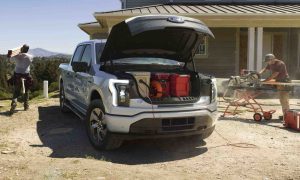
At The Curb
The limited range – and lengthy recharge time, even at a “fast” charger – may account for Ford offering the Lightning in Super Crew/short-bed configuration only. That is to say, Ford probably envisioned the Lightning appealing primarily to people who use it to transport people rather than haul 4×8 sheets.
And the super-roomy cab is a fine place to spend time, if you do have to wait for a charge.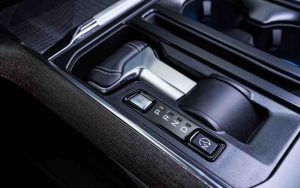
It’s also a great place to work while you wait. You can fold down the gear selector and then fold out the center console storage cover to make a flat table to put your laptop on.
As in the non-electric F-150 Super Crew, there’s more room in back than up front. Unlike the regular F-150, there’s also 14.1 cubic feet of room up farther front – under the hood. This “frunk” endows the Lightning with what no other truck has – that every car does. It’s not just the additional capacity that’s nice. It’s the convenience. A “frunk” is a better place for groceries and such than the back seats – especially if you have people riding back there.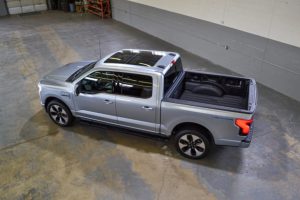
You will also find four household-style 120V AC power outlets in the “frunk” – as well as two more in the bed. These are standard – and can be upgraded to provide 9.6 kW of electricity so you can power higher-draw accessories. You can also us the Lightning to charge another EV with a run-down battery, using a special adapter.
Just be aware that every accessory that uses electricity will drain the battery, costing you range – and possibly time.
Otherwise, the Lightning is an F-150. It doesn’t look noticeably different from the non-electric version unless you look closely – or someone pops the “frunk” open.
The only other giveaway is the grille, which isn’t open to allow air to cool the engine that isn’t there. It’s a sheet of contrast-colored plastic that’s painted to look like a grille.
The Rest
A Catch 22 about the Lightning (and all electric vehicles) is that regular use of high-voltage “fast” chargers is not good for the long-term health of the battery. Ford says so, in the manual that comes with the Lightning. The reason being that feeding a lot of high voltage into any battery is hard on the battery. This is why it is usually recommended that one trickle charge a battery. And Ford recommends the same – as by charging it at home, on 120V household power.
This will help keep the battery “healthy” – by which is meant its capacity to accept and retain a full charge.
The catch is that doing it that way takes about 15 hours, which is a long time to wait if you need to use your vehicle. But if you use the “fast” charger regularly, you may need a new battery sooner – and electric vehicle batteries are very expensive. So expensive that it may not be worth buying a new battery, relative to the value of the EV after eight years or so.
This may change, of course. But – right now – batteries are becoming more expensive, because more EVs are being made.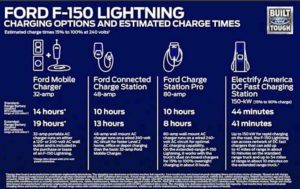
Ford does offer a mid-way solution called Charge Station Pro – that uses 240V AC electricity to reduce home-charging times 8-10 hours or so. But you’ll need to have an electrician come out to install the Charge Station.
Be aware that it is not possible to “fast” charge any electric vehicle at home, because private homes do not have the commercial high-voltage power (the wiring) necessary to be able to do that.
The Bottom Line
The Lightning lives up to its name. Its performance can be breathtaking. But it’s also gone, after a flash.
. . .
If you like what you’ve found here please consider supporting EPautos.
We depend on you to keep the wheels turning!
Our donate button is here.
If you prefer not to use PayPal, our mailing address is:
EPautos
721 Hummingbird Lane SE
Copper Hill, VA 24079
PS: Get an EPautos magnet or sticker or coaster in return for a $20 or more one-time donation or a $10 or more monthly recurring donation. (Please be sure to tell us you want a magnet or sticker or coaster – and also, provide an address, so we know where to mail the thing!)
My eBook about car buying (new and used) is also available for your favorite price – free! Click here. If that fails, email me at [email protected] and I will send you a copy directly!




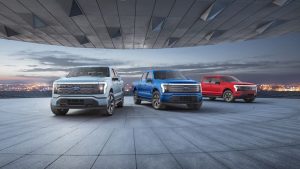
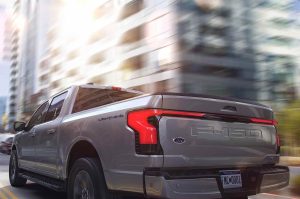








[…] acaba de pasar una semana conduciendo en pruebas (puede leer más sobre eso si lo desea, aquí here). Tienen radio satelital y radio FM, pero no radio AM. Sus sistemas de audio han tenido la […]
A useful article on the loss of EV range during cold weather:
Be aware that some of the numbers are estimated and others are measured.
https://www.recurrentauto.com/research/winter-ev-range-loss?utm_source=syndication
Something you’ll never hear here…. hear here, allens lookenspeepers…
American Cars Suck.
Let me simplify things.
In Japan and most likely Korea they make cars by specifying the part, and consistently use the same suppliers.
In Ermerca – they work in a random “free market” fashion, query several suppliers and guess what? They buy the cheapest one.
Chrysler is the worst, ford a close second, but they’re all ship anchors in my opinion. Been through that hell, never again.
American cars drive like a drunken slob, crap suspension, crap motor, crap interior, crap body, and totally unreliable.
Hi Whip,
I don’t disagree, generally – however, American cars drive about the same as other cars because they all drive about the same, now. I am among the few people who can state this with authority because I am one of the few people in the country who drives a different new car each week to test/review (and have been doing it for decades).
This video is about why people buy Porsches….their sports cars…..they have the best engineers in the world, so they make the best all round cars….all other cars are compromised in some way, or too focused on one purpose…like track focused cars….
A Super 7 is more a track focused car, so is a poor daily driver…but it’s redeeming quality is it is the most fun car to drive…..
Porsches link…why people buy Porsches
https://www.youtube.com/watch?v=rdJYiRROeAc
As a 27-year veteran of the US auto industry product development, I’ve been involved in teardowns of competitive vehicles. You can not tell that a Toyota or Lexus product will be very reliable by looking at individual part designs, estimating part weights, etc. Individually, the parts are not impressive. But as a whole, the vehicles are very good for the money and reliable That’s good engineering
At the time, Mercedes parts had a high estimated cost and were impressive designs. So their cars were very expensive as a result. That worked until Lexus showed up.
Good auto engineering is getting good performance without spending a lot of money on parts and having a lot of weight.
One clue to how that is done: The Toyota Engineering Program Manager for their Camry program stayed on the job for at generations over 16 years. And that was not considered to be a bad career move in Japan.
In the US, a Program Manager often did not stay with a vehicle team for the full four years, hoping to get transferred out or a promotion before the product was launched. Let someone else take the blame for reliability problems after launch.
The best US engineers were promoted to management positions where they no longer did any engineering. That did not often happen at Toyota in Japan. Japanese engineers also kept books detailing everything they had learned to pass onto any engineer who would replace them someday. Cooperation rather than the US “what’s in it for me” attitude.
Reuters sees the handwriting on the wall for the EeeVee Bubble:
‘In Europe, EVs account for about 12% of total passenger vehicle sales. But in the United States, EV market share is only about 6%. Among the barriers to EV adoption, industry executives and analysts said, were a dearth of public fast-charging infrastructure and the rising cost of EV batteries.
‘By 2025, there could be 74 different electric vehicle models offered in North America. But fewer than 20% of those models are likely to sell at volumes above 50,000 vehicles a year. Automakers could be stuck with too many niche models and too much capacity.
‘Slowing economies threaten overall vehicle demand in Europe and China, too.’
https://finance.yahoo.com/news/electric-vehicles-confront-leap-mass-120618652.html
Notice how the slowing US economy (probably already in recession) is not mentioned?
For now, the mainstream press expresses only mild caveats and cautions about the EeeVee Narrative.
But when unemployment shoots back up to 6 or 8 percent, the media will be crying doom … as some of us are doing now, when there’s still time to ‘panic early’ and hit the fire exit before everyone else does.
Too bad EeeVee Mary Barra is still swooping and vamping across the crowded dance floor, unaware that the upbeat music’s about to stop.
Hi Jim,
In re cost: Ford massively increased the base price of the ’23 Lightning – by $8,000. The Mach e is also similarly more expensive for ’23. So also the Tesla 3. Adding thousands in buy-in cost to an EV is like punching another (not pinole) leak in the “tank.” This little Mach e I have now is basically a compact crossover similar to a Mazda CX5 in terms of overall size/interior space and general layout. But the Mach e’s starting price is almost $50k, which is more than $20k higher than the base price of the Mazda. And the latter does not limit you to just 247 miles of indicated (more like 210, actual) range and having to orient your day around how much range you have left vs. how much time you have to put more in.
Who is going to buy these things? The better question, perhaps, is – who can afford to?
Base price plus delivery charge, options and sales tax. Add expensive insurance. And interest on your auto loan is no longer low. Who can afford that?
The auto industry will be begging for government subsidies in 2026.
‘Prices start at $48,769 for the base Pro trim.’ — eric
That was back in the halcyon, innocent days of August. But as ChrisIN pointed out, prices have gone up … WAY up:
‘Ford has increased the price of the base F-150 Lightning. The electric pickup truck now starts at $56,000 – more than $15,000 over its original pricing.
When Ford announced pricing for the F-150 Lightning, it surprised many with a starting price of $40,000. It appeared to aim to compete with Tesla’s Cybertruck base price announced a few years prior. However, the price didn’t last long.
In August, Ford increased the price of all the models by $6,000 to $8,000.
Then again, just a few months ago in October, Ford increased the base price of the F-150 Lightning to $52,000 this time.
Now Ford has again decided to raise the base price of the F-150 Lightning. It now starts at $55,974, according to an update on its online configurator.
https://electrek.co/2022/12/15/ford-f-150-lightning-price-increase/
A forty percent hike in five freaking months: that’s price stability, comrades! /snark
And if ya want the larger-battery XLT model that Eric tested, it’s yours for a low, low $80,974. /snort
Let us repeat: makers of material-intensive EeeVeees are getting blown the hell away by inflation. Price hikes are shrinking the buyer pool like an ice cube melting in the sun.
The idiotic EeeVee bubble is popping before our very eyes. There will be blood when the EeeVee clown car smacks the wall head-on and burns to cinders. You have been warned, Mary Barra.
I did a quick msrp cost per trim level:
a Lariat Lightning is 74K and the gasser is 57K. Platinum Lightning is $96K and gasser is 64K.
So about 17K to 29K differential buys a lot of gas, from 5000 gal at $3.50/g to 8000 gal. or 85,000 miles (17mpg) to 136,000 miles.
BTW, in my price examples for Lightning vs gasser, I didn’t realize the Lariat Lightning I said was 74K was for the smaller battery. Add another 10K for the larger battery or 84K. So that adds another 2800gal of gas at 3.5/gal, and 48K miles to the difference.
‘Hydrogen powered SUV with 500 mile range…’
“NAMX and Pininfarina show off HUV with removable capsule tanks”…
https://citizenfreepress.com/breaking/would-you-drive-it-hydrogen-powered-suv-with-500-mile-range/
I’m sure it’s cheap.
Thinking about that & the possibilities might be a good break from thinking about how the ~Andromeda Strain shedding is affecting us all, looks like, especially pureblood children:
‘Tsunami of Vax Deaths Coming in Next Two Years – Dr. Betsy Eads’
By Greg Hunter On December 13, 2022
https://usawatchdog.com/tsunami-of-vax-deaths-coming-in-next-two-years-dr-betsy-eads/
…Sad tale, of woe.
The 80% fast charge is because after 80-85% the charging current must taper off, below that of regular charging (which may be still more than a home charger can do depending on the particulars of the pack). Blasting cells with max current beyond 80-85% will damage them and could cause a fire. Hence the cut off. A fast charger is pretty pointless after than since it must behave like a normal charger. Each % of charge after 80-85% will take longer too as the current reduces. Diminishing returns.
Eric, did you ever notice some kind of uneasiness while driving the Lightning?
I wish I had a better word than, uneasiness.
I used to drive a battery powered forklift in a factory. I hated it.
It’s been quite a number of years since then. I do recall that it gave me this,… uneasiness from sitting on top of the battery.
It was a huge sense of calm whenever I would hop off & get on a propane powered forklift. HUGE.
Mercola writes about EMF’s from a simple 120 house-wiring in the walls of house…
https://www.lewrockwell.com/2012/02/joseph-mercola/beware-of-these-5-home-appliances/
I wonder about sitting on those batteries.
I imagine they probably have shields between the battery & the driver/passengers?
I wonder, too, how well they work, IF they are even there?
…Fun Times. …Trust, “the experts”?
What am I missing? Who the hell needs a truck that can do 0 – 60 in 3.8 seconds? Or 775 lbs/ft of torque? Couldn’t they reduce the power and thereby extend the range? If this thing did 0 – 60 in say, 8 seconds, with a 400 to 450 mile range, you might have a winner. Whether it’s this or Tesla or whatever, I don’t understand the focus on mind boggling acceleration instead of range.
What your missing is how an EV works.
They could probably remove one of the motors and save a little weight while reducing the power.
That wouldn’t help the range in any noticable way.
You still have to move that weight with the other motor and it will still are just as much (or nearly anyway) as much power to do it.
EVs are not like internal combustion engines.
Also, that applies to those ranges they give you.
You’ll never see the stated range on a highway trip. The highway range is less and the city range is more. Totally the opposite of an ICE.
Hi Nate. Still doesn’t make sense. This has 475 horsepower. If it had say, a 250 hp motor instead, wouldn’t that use less electricity than a 475 hp motor? If you kept the same battery bank, it seems that the smaller motor should go farther before needing a recharge. Sure, with “only” 250 hp, you won’t go from 0 to 60 in 3.8 seconds, but again, who really needs that? 7 – 8 seconds is pretty acceptable, especially in a truck. Yes, you still need to move roughly the same amount of weight, but you don’t need to move it that quickly. Pretty sure that all else being equal, a bigger motor uses more energy, no matter the source of that energy.
You need to stop looking at how much horsepower is available to the motor or motors.
That’s not really relevant, assuming it has enough to go down the road.
Let’s say you want your EV to go 100 miles at 75mph. That’s going to take a certain amount of power (HP or kW, 1 hp = 745.7w). It doesn’t matter if it is capable of 2000hp or 200hp, it’s still going to take an exact amount of power to do it. That’s what drains your battery.
You’re stuck in thinking about how an ICE typically works in regular use, and they have their own issues as far as efficiency. In a way, an EV is far easier to understand.
Hi Nate,
I submit it’s not the range, per se, that is the fundamental problem. My Trans-Am doesn’t have much range, either. The problem is the recharge. Even if my TA burns through a full tank in 200 miles of driving, it is a simple matter to continue driving. Refuel to full in minutes. Back on the road. When an EV runs out of charge, you are looking at a minimum stop of 30-45 minutes to recover any meaningful range before you can proceed again. And now the problem compounds because even at a “fast” charger, you have only recovered a partial charge. So you resume your trip with less range. If your trip is farther than that range, you will have to stop, again.
The problem is compounded further by the fact that EV range is not the same as IC range. My Trans-Am’s range is consistent and so predictable. I know, ahead of time, how far a full tank is going to take me – irrespective of cold or hot outside. With an EV, range – actual not indicated – can and does vary greatly.
So, a putative 300 mile EV range may prove to be only 220. Or less, if you’re towing.
I can tell you the delivery service driver had to stop for a charge twice on the way to my place, to drop the truck off. Normally, they stop once – just before they drop off the vehicle, to run it through the car wash so it’s clean when they leave it.
It took them about two hours longer to make the trip.
I don’t disagree at all. Actually I think an EV pickup truck is about the worst use of EV technology. It just isn’t quite there yet, so we scale it up?
An EV could make a good commuter vehicle though. The smaller the better.
As for a truck like this, it could be useful to my city that drives around in F-150s and I doubt they put very many miles on each day. They could charge it all night too, since they aren’t working then.
We’re going to see lots of dummies buy these and try to haul their trailers around. It won’t go well for them.
Hi Floriduh,
I think it’s not so much the horsepower as it is the weight needed to deliver it! This truck weighs more than 6,200 pounds – and something like 1,500 pounds of that is battery weight.
A friend is a recently “forced to retire” EV electrical engineer. I had asked him about what seemed like unnecessarily fast EV acceleration. His response was that faster acceleration did not add much cost for the electric motors, did not have much effect on range if you drove reasonably, but was good for sales. His general opinion was that not many customers were going to be happy with their expensive EVs, but some would be thrilled by the fast acceleration.
Advanced engineering was working on the use of supercapacitors with smaller electric motors for EVs, sort of like using turbochargers with small ICE engines. The conversation was over my head, but he did say supercapacitors could not be used to replace batteries, and batteries would be the EV’s weak point for many years to come.
He was not happy about being forced to retire from product development a few years before he had planned to retire, but he had never before been thrilled by the EVs he was working on. He does not think EV repair costs will be lower than ICEs, especially with the lack of mechanics that have EV experience.
A lot of auto engineers are worried that their customers are not going to be very happy about being forced to buy EVs in the future, assuming they can even afford EVs. My friend says he’s going to take his pension as a lump sum before his company launches lots of EVs and starts losing money. That may be a biased statement, but he was a long-time industry insider until recently.
Hi Richard,
The bottom line is most people simply cannot afford EVs, irrespective of any appeal they may have. A new Hellcat Challenger is very appealing to me. But I cannot afford one, so…
Except for very small (and so essentially useful only as commuter car) EVs such as the Chevy Bolt, most EVs sticker close to $50k. That represents a roughly $15k increase in the average transaction price of a new car. It is easily $25k more than the price of a family car such as a Toyota Camry (base trim). This is not … what’s the word? Sustainable.
It wasn’t two years ago – because most people do not have the income to support buying $50k-plus cars. But now? When the buying power of the money they have has been reduced by 7-12 percent?
The only way EVs will ever become other than boutique cars for the affluent will be if costs go down – a lot. In fact, costs are going up – because the materials necessary to make EV batteries are becoming more rather than less costly.
This is not going to end well.
So in the real world, this truck is only good for a suburban soccer mom to drive johnny to school I guess…. ironically meaning an even heaver car is used damaging the roads more !! once everyone has these I’m sure the world will be a better place…
Just what very family needs: A very expensive, inconvenient, second car that run on electricity?
Hi Richard,
I just posted my review of the Mach e . . . which is sitting outside, recovering range as I type…
>Super Crew/short-bed configuration only.
Personally? Not interested.
I have no use for a crew cab, and a 5.5′ bed with very high sides just does not meet my requirement.
My single owner, single cab, 8′ bed, ’89 F150 suits me just fine.
Bed sides are low enough to load and unload without a stepladder.
Fuel injected, 87 octane gasoline powered, 300 CID straight 6, 4 speed (3 + granny), 2WD, gets me everywhere I need to go. Range w/ 2 tanks is 400-500 mi., depending.
Passenger car radials on 16″ wheels are economical, and perfectly adequate for hauling slightly more than the rated 1/2 ton.
Hit or hold? I’ll hold.
“I have no use for a crew cab, and a 5.5′ bed with very high sides just does not meet my requirement.”
I copy that, Adi.
Hi BaDnOn,
I echo that! None of the current half-tons appeal to me. They are just too big – and the bed walls are silly high. Combine the latter with the way they’re all “lifted” now and it makes it very awkward to make use of the bed. If it’s a short bed… ? My little Nissan has a longer bed than some of these massive, road-going Titanics.
‘My little Nissan has a longer bed than some of these massive, road-going Titanics.’ — eric
I mirror that — so does my little Nissan. It’s a nominal 6-foot bed, maybe an inch over.
Every spring and autumn, I pile it high with pine needles — easily reaching over the sides, and easily stepping up on the bumper, then on top of the pile to tread it down and load more.
Let’s see any 2023 model, 5,500-lb monster pickup compete with that ease of use. They can’t, they’re too freaking big … blown up like the Michelin man into near uselessness. Pffftt!
Why of why did Ford Motor Company build the all electric Lightning? Because of politically driven climate change agenda – which is 100% BULLSHIT. The planet is not warming, CO2 does not affect temperature, and all of the doomsday alarmist predictions have failed.
For instance Al Gore (who never took a collegiate science course, flunked high school chemistry, knows nothing about climate science) predicted the arctic would be ice free:
https://electroverse.co/al-gore-ice-free-arctic/
“On December 13 and 14, 2009 professor, prophet and soothsayer Al Gore predicted the North Polar Ice Cap could be completely ice free within the next five to seven years.”
——————
Well I say Ford Motor got bamboozled into the electric car market by the left wing fake climate narrative, and I predict that there is an excellent chance this whole electric car delusion will have a headon with reality and cost the car companies mucho shekels.
The car industry is a wreck of failed companies over time:
https://en.wikipedia.org/wiki/List_of_defunct_automobile_manufacturers_of_the_United_States
—————–
https://wattsupwiththat.com/2020/12/08/guardian-children-wont-know-what-snow-is-again/
“Breitbart reports the main stumbling block was the Royal Society scientists apparently refused to accept contradictory observations as evidence their models could be wrong. When challenged, they claimed they would need an additional 50 years of contradictory observational evidence, we would all need to wait until the year 2047, before they would consider admitting they had a problem.
There is not much you can do to persuade people who appear to openly admit they discount the value of observational evidence which contradicts their computer models. Though such people do have some entertainment value, when they solemnly share their latest predictions.”
——————–
If you think that is funny, it gets much better, these climate hacks – who take grants to prove the narrative true, go to poles and get stuck in the ice on a regular basis. They actually think their computer models are valid – and they go to the arctic – then get stuck in the ice.
https://www.foxnews.com/science/stuck-in-our-own-experiment-leader-of-trapped-team-insists-polar-ice-is-melting
“It’s interesting that the first electric vehicles of the modern era weren’t trucks”
The late 1990s era S10 and Ranger electrics would like a word with you.
Unless… that’s not what you meant by modern.
Hi Nate,
If I’m remembering the ’90s correctly – and I may not be – those weren’t mass market/regular production vehicles.
Oh, probably true. So that’s kind of like half the EVs out today.
RE: “those weren’t mass market/regular production vehicles.”
Hell yeah. Battery powered forklifts, I knew about and drove.
…Battery powered light trucks in the 90’s?
I had no idea there even was such a thing back then. Probably as rare as a 350 ci swapped into an S-10. At least I saw one of those, once.
Thanks Eric for an honest balanced look at what it’s like to live with an EV. This is not something to be found elsewhere in green zealot auto journalism.
My pleasure, Robbie –
The kind words are appreciated!
Watch and be forewarned.
https://www.youtube.com/shorts/-5frrNKA7qk
This will be primarily used by large installations like airport and retirement community maintanance crews. Places where maintaing a pool of fleet vehciles is a PITA. Instead of having gasoline pumps on site (and all the storage tank paperwork required for the EPA), sending a worker out to a mechanic for a day to keep it repaired, and all the other stuff that goes along with gas vehicles, just get a few of these and install some 240 chargers (with all that free Build Back Better money). For these scenarios it will be great. Just drive to the yard behind the shop and plug ’em into the 240 charger overnight. Next morning it’s all ready to go. If the boys go back to the shop for lunch or the quarterly HR sexual harassment training, plug it in. Change the tires every two years or after they’re rotted away. Because they’ll rarely go off the site, run the charge way down or travel at highway speed the battery pack will last longer than designed too.
But that’s a very niche application. Certainly not worth all the design and engineering expense wasted by Ford on the project. Sounds like it’s more of a conversion than a new vehicle (given the “frunk” where the engine should be and the battery pack inbetween the frame rails) this should be outsourced to a finisher, like 1980s GM convertibles.
‘The Lightning has a massive battery pack – some 1,500 pounds of its more than 6,200 lb. curb weight.’ — eric
ARRGGGHHH! *covers mouth and gags* But I’m an outlier according to Wolf Richter, a former Ford dealer. He published excerpts from an EPA report showing that Americans are buying vehicles that are “faster, more powerful, more fuel-efficient, heavier, and bigger (and they’re a lot more expensive because that’s where the money is).”
Nevertheless, the F-150 Lightning is a thousand pounds heaver than the average bloated pickup. Forty-four year weight chart:
https://wolfstreet.com/wp-content/uploads/2022/12/US-auto-EPA-weight-2022-12-12.png
But the ‘more expensive’ bit is what they’ll choke on, in the unfolding recession. Ford shares are off about 45% from their high in January. Tesla’s been smacked down almost 60%, costing Eeeeeeelon his title as the world’s richest lifeform.
Big Gov was the pied piper who led credulous auto execs such as EeeVee Mary Barra down the primrose path. But now, with the auto biz taking an ugly turn southward, they are on their own. Sorry guys! Better luck in mid-decade, if you’re still around!
Wolf writes many interesting pieces. I don’t agree with him on EVs, though. I guess you have to remember that he lives in San Francisco.
I concur. Wolf assumes that EeeVees will take over the new vehicle market, because Big Gov says “Make it so.”
But Big Gov can’t make people buy costly vehicles. Recession will throw a big spanner in the works. Maybe it will even prompt a ‘cash for EeeVees’ program like ‘cash for clunkers’ in 2010. Get those broken-down EeeVees with worn-out batteries off the road.
I just wanted to add that we’re all supposed to be terrified of invisible “viruses” while embracing equally invisible EMF as the Internet of things and Internet of people becomes a reality. EMF is invisible, but AM radio easily detects it. This is why AM is being phased out on these new electric vehicles.
I think that the amount of EMF in one of those things, particularly while charging, is much more important than the range. It wouldn’t be wise to be in that faraday cage while charging. Tests need to be made with an EMF meter. I’ve only seen one guy do a good job of it, with a Tesla. The levels were highest in the dealership, ostensibly because the car was talking to the mother ship. All new cars emit a good deal of EMF but sitting on a giant battery takes it to the next level. Like driving around in a microwave oven.
Remember, cant listen to AM radio because of the radiation
For the $$$, Id buy a manual taco off the lot and diesel swap it (https://www.dieseltoys.com/2016-2023-tacoma), be infinitely more useful than a Lightning ever could be
Eric, the videos you posted about the inconvenience of living with an EV were amazing. To me, the most interesting thing about this vehicle isn’t the normal car stuff (0-60, handling, cargo capacity, comfort, etc.) but how much you have to plan your day around the vehicle instead of vice versa.
I towed my boat down to the coast (about a 70-mile trip one way) for some fishing, caught some nice tripletail and Spanish mackerel. My truck has a 27-gallon tank and it usually gets about 10 mpg towing my 21-foot fishing boat. I didn’t have to gas up except to top off the tank for the week’s driving. I had a full tank when I left and my truck told me I had about 130 miles of gas in the tank when I turned for home, more than enough to make it there with room to spare.
If I would’ve had your Lightning “truck” towing my boat, I would’ve had to stop to charge, which is impossible in NW Florida being that there aren’t any chargers of any sort on the country roads away from the coast. It’s easy to see that the inconvenience is baked into the cake, kind of like having to wait for a bus or a train instead of being able to get into your vehicle and LEAVE ANY TIME YOU WANT.
Fair, informative and comprehensive.
You’ve done well, here, Eric.
The truck actually sounds somewhat decent for someone not looking to make long hauls. if only the battery pack would last maybe 20-25 years, it might be a worthwhile purchase.
Maybe the engineers could figure out a way to attach a lightning rod to the vehicle and channel the electricity to the battery when it gets hit by lightning.
Hell, you’d get 1.21 gigawatts outta that, Mike! Should charge that pack right quick.
…and if you’re tooling along at 88 mph when that happens?
https://yewtu.be/watch?v=Dl5NdHGozUM
Serious shit is right, Scott. 🙂
Fair & honest review, Eric. Good job.
I’ve never looked but I bet the range would really drop in an Alaska winter or Mississippi summer’s drive. My other guess is that what ever you save on gas wouldn’t be enough to pay for new batteries if you owned it in 10 years though.
Doesn’t sound like there are any “savings” when you actually have to pay for the electric you use. Been hearing stories of how it costs $100 to fuel an electric Hummer.
The “free” fuel ups for electric vehicles are vanishing quickly.